Brooks Street stands as a vital transportation corridor in Missoula, Montana, but its current form struggles to effectively serve the evolving needs of the community. For years, the City of Missoula has recognized the necessity to transform Brooks Street from a car-centric commercial strip into a multi-modal artery that seamlessly integrates into the urban fabric, connecting residents to homes, workplaces, services, and recreational opportunities. The “Transform Brooks – Connect Midtown” project is a significant initiative aimed at realizing this vision, and your input is crucial to shaping its future.
Latest Project Updates on Brooks Street
January 2025 Update: BRT Configuration Analysis for Brooks Street
Responding to valuable feedback from Midtown business owners, property holders, and community stakeholders, the Transform Brooks team is diligently evaluating two distinct Bus Rapid Transit (BRT) configurations for Brooks Street. Consultants are currently analyzing a side-running BRT model, comparing it against the previously considered center-running design.
The side-running BRT configuration proposes integrating buses within existing travel lanes, with station stops conveniently located at the curb. This in-depth analysis will provide a balanced comparison of both configurations, meticulously examining factors such as potential traffic impacts on Brooks Street, pedestrian accessibility and ease of movement across Brooks Street, the efficiency of bus operations, and competitiveness for federal funding. The Transform Brooks team anticipates presenting this comprehensive analysis, along with a recommended BRT configuration, at a public meeting scheduled for this summer.
November 2024 Update: Side-Running BRT Configuration Considered for Brooks Street
During the summer of 2024, Midtown business and property owners, alongside other engaged stakeholders, encouraged the Transform Brooks – Connect Midtown design team to explore a side-running BRT configuration as a viable alternative to the center-running BRT initially proposed.
In response to this community input, the project sponsors, namely the Missoula Redevelopment Agency and Mountain Line, have committed additional funding to expand the project’s scope and timeline. This expansion allows for a thorough evaluation of the side-running BRT concept.
Similar to the center-running option, the side-running configuration aims to enhance public transportation along Brooks Street. The current analysis is focused on equitably assessing the benefits and drawbacks of each approach. Key considerations include traffic flow on Brooks Street, pedestrian access across the corridor, operational aspects of the bus system, and the project’s eligibility for federal funding opportunities. The findings of this comparative analysis are expected to be presented to the project Steering Committee by mid-February 2025.
While the project team navigates various complexities, certain aspects are gaining clarity. Ridership data suggests that the Stephens Avenue/Orange Street route is likely the preferred BRT path connecting Midtown and Downtown Missoula. Furthermore, updated information indicates that positioning the southern terminus near Mary Avenue West, rather than south of Reserve Street as initially planned, would be more advantageous. This revised location would place a central bus transfer station within Midtown, fostering significant potential for transit-oriented development around Brooks Street. With these key elements becoming clearer, the project team is now focusing on identifying optimal locations for station stops between Midtown and Downtown along the Brooks Street corridor.
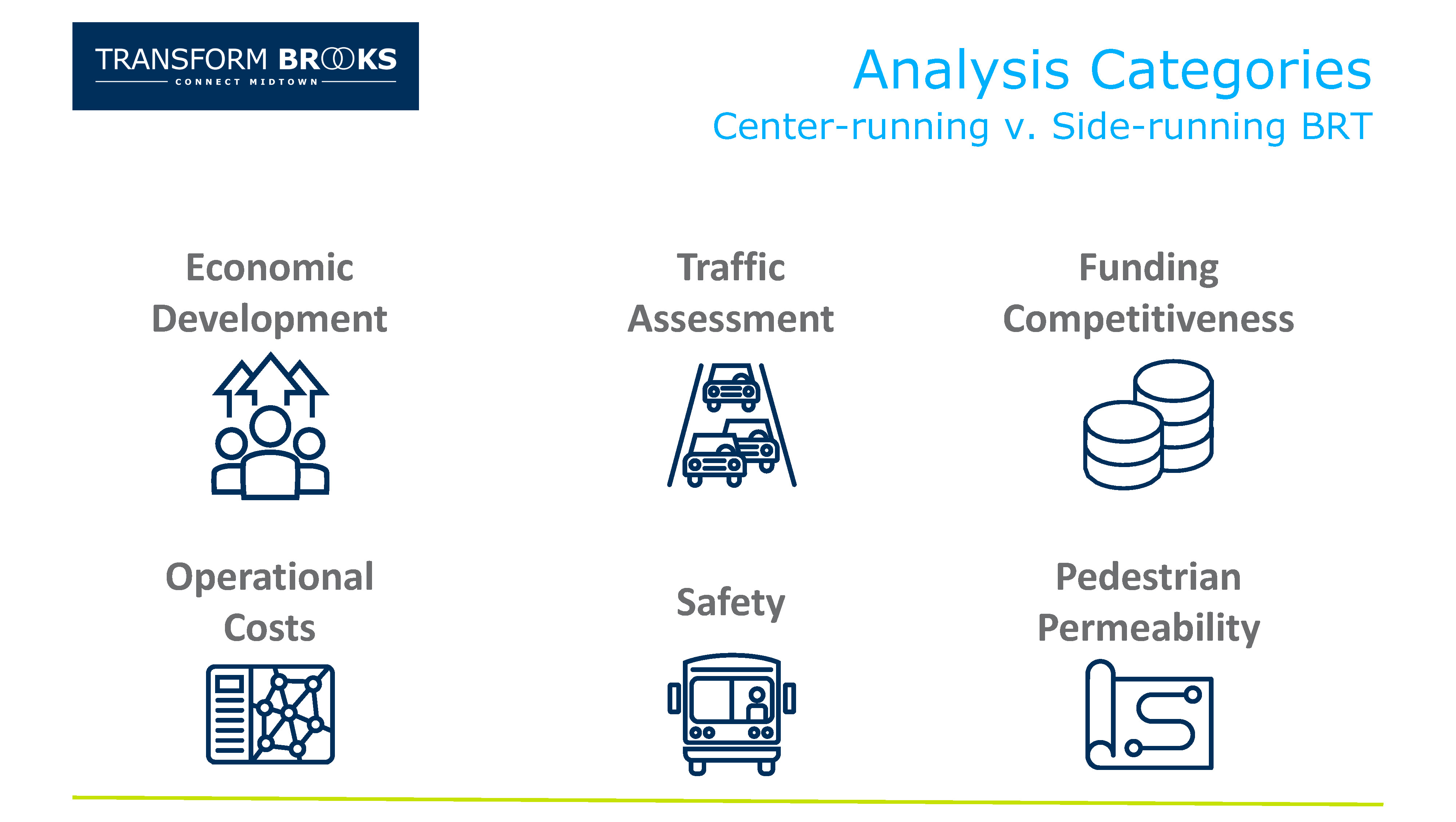 Brooks Street BRT Configuration Analysis: Evaluating Center-Running and Side-Running Options for Missoula's Transform Brooks Project
Brooks Street BRT Configuration Analysis: Evaluating Center-Running and Side-Running Options for Missoula's Transform Brooks Project
September 2024 Update: Leadership Changes and Project Momentum
Leadership transitions within partnering agencies have occurred over the summer, influencing the Transform Brooks – Connect Midtown planning study. At Mountain Line, Jordan Hess, former Mayor of Missoula and a long-time transportation director at the University of Montana, succeeded Corey Aldridge as CEO and general manager in mid-August. Additionally, Chris Dorrington was appointed director of the Montana Department of Transportation (MDT) in June, replacing Mack Long. Mr. Dorrington previously served as director of the Department of Environmental Quality (DEQ) and chair of the Governor’s Housing Task Force. While the project team maintains close collaboration with regional MDT staff, these leadership changes present a renewed opportunity to emphasize the importance of the Transform Brooks project to Missoula’s broader transportation network and to the urban development of Midtown along Brooks Street.
May 2024 Update: Project Schedule Adjustment for Design Refinement
Transform Brooks – Connect Midtown is an ambitious and intricate undertaking focused on developing concept-level designs for enhanced transit, pedestrian and bicycle infrastructure, and roadway improvements. These improvements are envisioned to have a transformative impact on Midtown Missoula, specifically through fixed-route transit and permanent bus stops along Brooks Street, coupled with high-frequency transit connections to other parts of the city.
The initial project timeline anticipated a second public meeting this spring to showcase design concepts. However, as is common with large-scale projects of this nature, certain design elements require further refinement and deliberation before presenting preferred concepts. These areas needing additional attention include exploring alternative locations for the southern termini of the project and considering different configurations for bus lanes on Brooks Street itself.
To ensure adequate time for refining these design options, the Transform Brooks design team has extended the project schedule by a few months. This extension underscores the commitment to a well-considered and community-responsive plan for Brooks Street.
Project Overview: Reimagining Brooks Street for a Connected Midtown
For over two decades, the City of Missoula has grappled with a challenge shared by numerous American cities: transforming Brooks Street. Originally designed as a highway commercial strip prioritizing automobile traffic, the goal is to reimagine it as a multi-modal transportation route that seamlessly integrates with the surrounding urban environment.
In 2015, a diverse group of Missoula residents united, recognizing that maintaining the status quo on the Brooks Street corridor would hinder the city’s Growth Policy objectives of “focusing inward” and promoting compact, infill development. This coalition, known as Midtown Mojo, articulated a vision statement emphasizing a vibrant and accessible Midtown for all Missoula residents. Key components of this vision include desirable and affordable housing, accessible transit connecting various modes of transportation, and pedestrian-friendly streetscapes with thriving commercial corridors that serve adjacent neighborhoods. Midtown Mojo identified highly efficient transit as the cornerstone of this urban design approach for Brooks Street and Midtown.
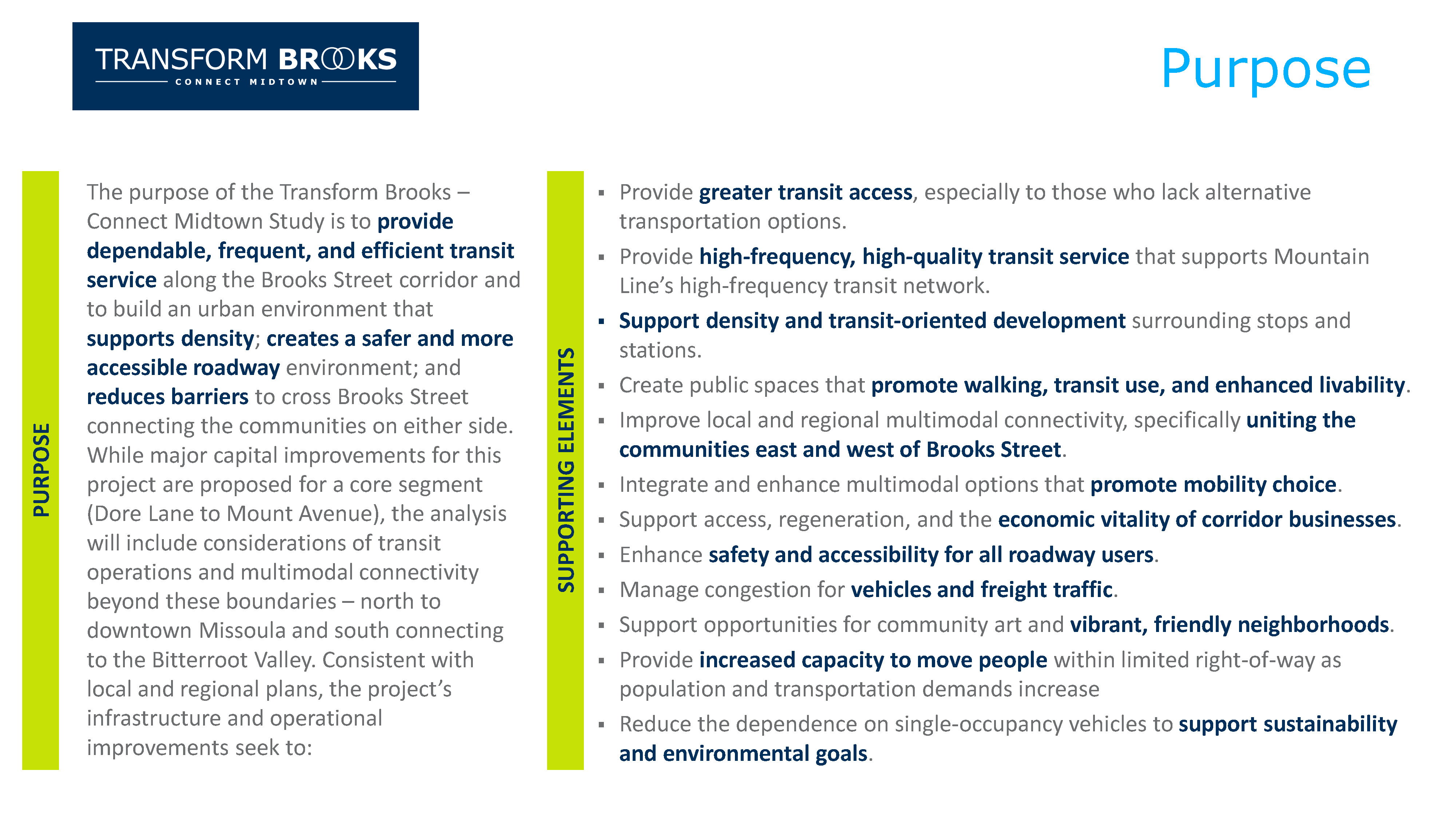 Purpose of the Transform Brooks Project: Enhancing Connectivity and Mobility on Brooks Street in Missoula
Purpose of the Transform Brooks Project: Enhancing Connectivity and Mobility on Brooks Street in Missoula
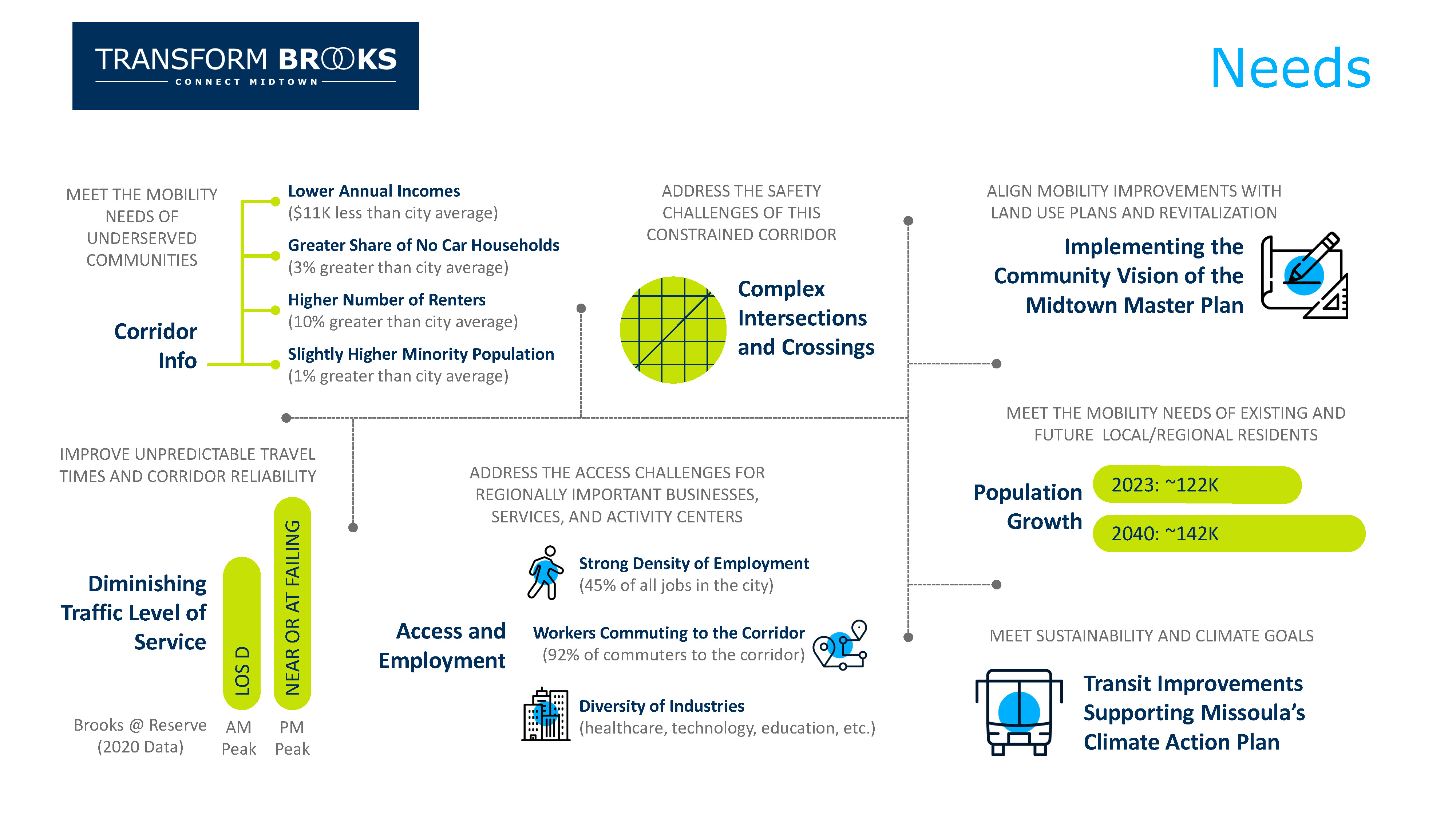 Project Needs for Brooks Street Transformation: Addressing Growth and Improving Transportation Efficiency in Midtown Missoula
Project Needs for Brooks Street Transformation: Addressing Growth and Improving Transportation Efficiency in Midtown Missoula
The central question guiding the Transform Brooks – Connect Midtown Detailed Planning Study is: How can we accommodate Missoula’s growth inward and enhance transportation efficiency along and across Brooks Street and the broader Midtown area? The City of Missoula and the Missoula Urban Transportation District (Mountain Line) are collaborating to answer this question through this study. Funded by a Federal RAISE Grant, this study builds upon previous community engagement efforts in 2016 and 2020, which advocated for fixed-route bus-rapid transit (BRT) and transit-oriented development (TOD) along the Brooks Street corridor.
Transform Brooks – Connect Midtown aims to advance prior planning work by formally defining safety and mobility improvements along Brooks Street, specifically between Reserve Street and Mount Avenue. The study will produce concept-level designs for transit, pedestrian, bicycle, and roadway enhancements. A consultant team led by HDR and DJ&A has been selected to spearhead the Transform Brooks – Connect Midtown study, under the joint management of the City and Mountain Line.
Community involvement remains paramount throughout this study, mirroring previous planning initiatives. Missoula residents, property owners, and business operators will have multiple opportunities to engage with the project team, ask questions, and provide valuable feedback to shape the transformation of Brooks Street.
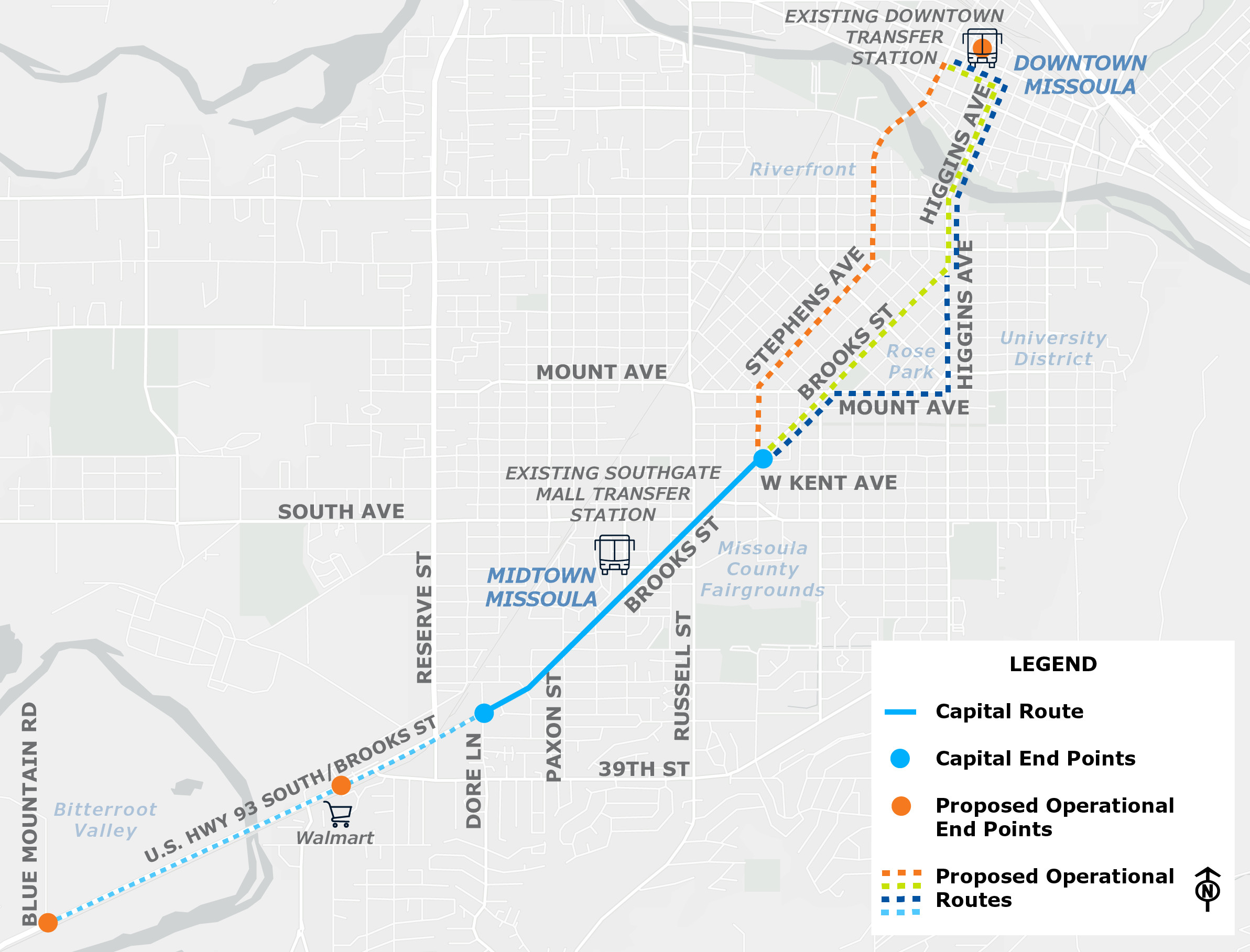 Brooks Street Corridor Study Area Map: Defining the Scope of the Transform Brooks – Connect Midtown Project in Missoula
Brooks Street Corridor Study Area Map: Defining the Scope of the Transform Brooks – Connect Midtown Project in Missoula
Understanding Bus Rapid Transit (BRT) on Brooks Street
Bus Rapid Transit (BRT) is a high-quality transit system employing dedicated bus lanes, permanent stops, and frequent service. BRT systems offer enhanced reliability, convenience, and speed compared to traditional bus services.
Across the United States, BRT projects are catalysts for localized economic development in numerous communities. The tangible infrastructure of BRT can signal long-term commitment to developers, encouraging investment and increasing accessibility to key employment and activity hubs situated along the BRT corridor, like Brooks Street in Missoula.
Prior planning initiatives identified BRT as a compelling strategy to address safety, transportation, and economic challenges along Brooks Street. The Transform Brooks – Connect Midtown study is further evaluating whether center-running BRT, or potentially side-running BRT, is the most suitable concept for Brooks Street. The study will formally define the requirements for implementing the chosen BRT concept and assess its potential economic benefits for Midtown Missoula and the Brooks Street area. This project is still in its initial phases, and the project team actively seeks guidance and input from community members, local stakeholders, and the broader public throughout the process.
Potential Benefits of BRT for the Brooks Street Corridor:
- Dedicated bus lanes ensure efficient bus travel, even during peak traffic hours on Brooks Street.
- Permanent bus stops and dedicated lanes signal to developers the City’s support for robust infill development along Brooks Street.
- BRT infrastructure can reduce pedestrian crossing distances at strategic points, enhancing safety and comfort for those crossing Brooks Street.
- BRT services can contribute to reduced emissions by promoting high-capacity transit and decreasing the number of private vehicles on Brooks Street.
- BRT service can potentially lower traffic accidents by minimizing bus/vehicle interactions and reducing overall vehicle volume on Brooks Street.
Potential Challenges of BRT for the Brooks Street Corridor:
- Modifications to travel patterns, such as restricted left-turn lanes at certain intersections, might lead to less convenient access to some locations along Brooks Street.
- Construction activities will inevitably cause short-term inconveniences for businesses and residents near Brooks Street.
- Acquiring additional right-of-way may be necessary in certain areas of the Brooks Street corridor.
- Some community members may express resistance to the increased density associated with transit-oriented development around Brooks Street.
- BRT projects necessitate substantial funding, often requiring competitive applications for federal funding sources.
Past Studies Informing the Future of Brooks Street
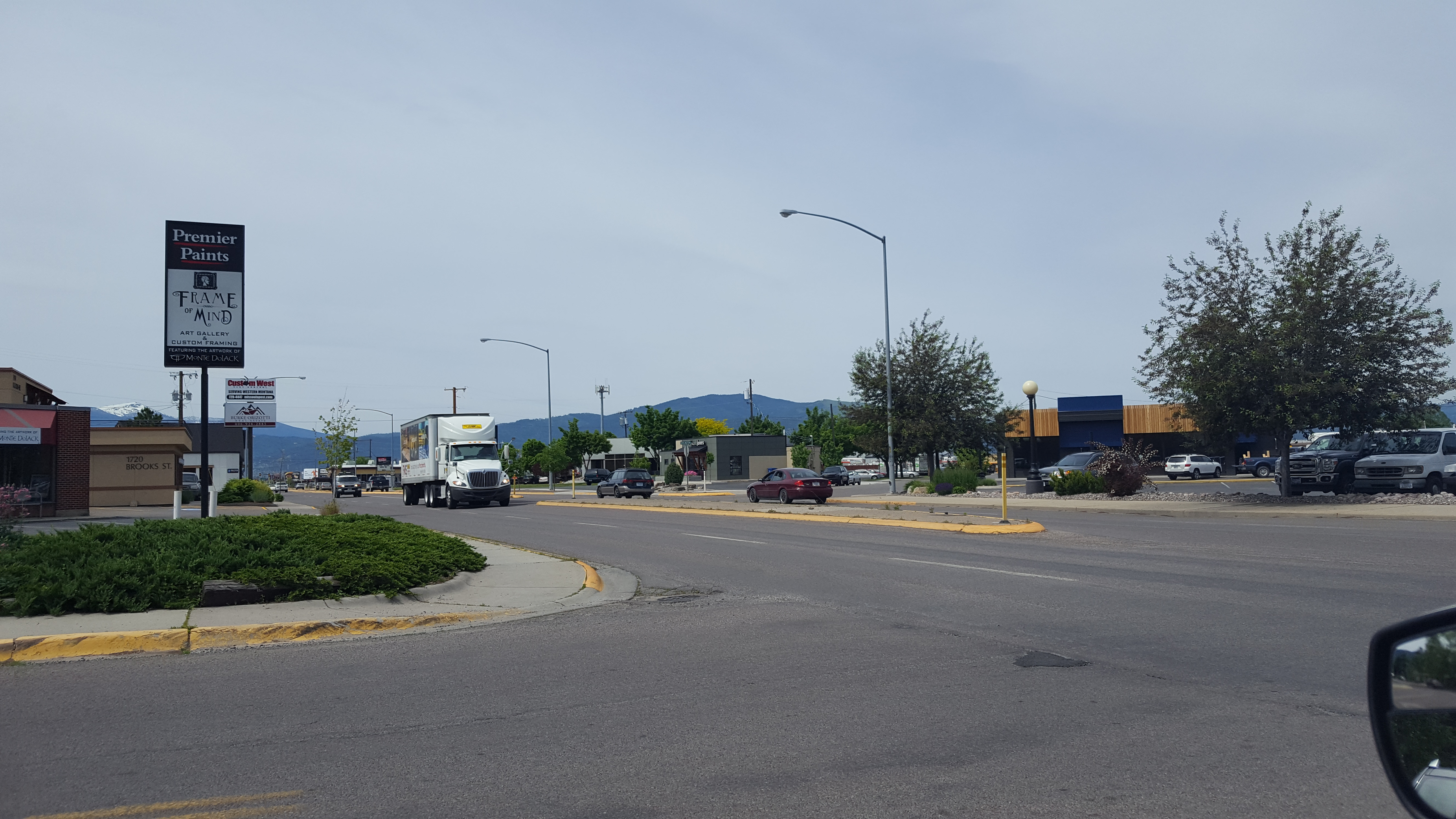 Existing View of Brooks Street in Missoula: Highlighting the Need for Transformation and Multi-Modal Improvements
Existing View of Brooks Street in Missoula: Highlighting the Need for Transformation and Multi-Modal Improvements
The Brooks Street Corridor Study, finalized in 2016, affirmed a community-wide desire to prioritize transit-oriented development (TOD) on Brooks Street, between Reserve Street and Mount Avenue. The subsequent Brooks Corridor TOD Infrastructure Study, completed in 2020, solidified the exploration of BRT as a viable option for this corridor. Transform Brooks – Connect Midtown represents the next crucial phase in this planning progression, advancing concepts from initial ideas to schematic design.
Furthermore, the Missoula Midtown Master Plan project, an initiative spearheaded by the Missoula Midtown Association, provides valuable insights and design concepts that will inform the Transform Brooks – Connect Midtown study. A primary objective of Transform Brooks – Connect Midtown is to leverage Midtown’s transportation network to bolster the planning strategies outlined in the Midtown Master Plan along Brooks Street, creating a cohesive vision for the future of this important corridor.
We encourage you to stay informed and participate in shaping the future of Brooks Street! Your feedback is essential to ensuring this transformation effectively connects you and others in the community to home, work, services, and recreation.
